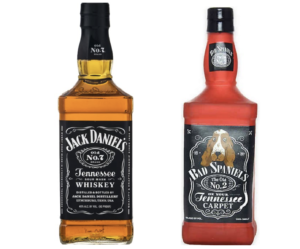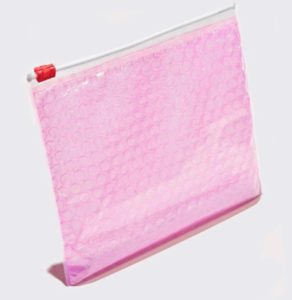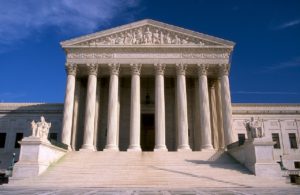By Cameron Bray
On March 22, 2023, the Supreme Court will hear oral arguments[1] in the case of Jack Daniel’s Properties, Inc. v. VIP Products LLC,[2] which will determine the fate of the controversial “Bad Spaniels”[3] rubber dog toy.[4] The Bad Spaniels dog toy was created in 2013 by the Respondent, an Arizona limited liability company in the business of designing and selling dog toys for retail,[5] known commonly as “VIP.”[6]
Besides “Bad Spaniels,”[7] VIP also sells the Tuffy or “Tuffy’s Dog Toy” brand[8] and the “Mighty” line for stronger dogs.[9] The Petitioner, Jack Daniel’s Properties, Inc. is a Delaware corporation, with its principal place of business in California, that owns and licenses the trademarks and trade dress used for wholesale of Jack Daniel’s whiskey.[10]
The Tennessee corn mash whiskey for which Jack Daniel’s is known has been sold domestically since 1875[11] and was halted briefly by Prohibition.[12] At the trial court level, Senior Judge McNamee of the United States District Court for the District of Arizona granted partial summary judgment upon cross-motions of the parties[13] and the court also entered a permanent injunction, enjoining VIP from commercialization (marketing), distribution, or sale of “Bad Spaniels” after a four-day trial without a jury.[14]
Reviewing VIP’s appeal[15] and the trial record for legal conclusions de novo,[16] the United States Court of Appeals for the Ninth Circuit unanimously[17] found that “Like the greeting cards in [Gordon v. Drape Creative, Inc.],[18] the [‘Bad Spaniels’] dog toy, although surely not the equivalent of the Mona Lisa, is an expressive work.”[19] It applied the well-known Rogers[20] test for expressive works under the Lanham Act[21] and held that the Bad Spaniels dog toy was indeed entitled to First Amendment protection.[22]
In terms of First Amendment law[23] and intellectual property (“IP”),[24] Jack Daniel’s Properties, Inc. v. VIP Products LLC is the most important constitutional IP case that the Supreme Court has reviewed since Matal v. Tam[25] six terms ago.[26] It has the power to abrogate Rogers and decide what parodies may be protected under the Free Speech Clause of the First Amendment, which is now in conflict with the two commonly claimed trademark actions under the Lanham Act.[27] If the Court is divided in its opinion, over two dozen amicus briefs have been filed in the case,[28] including from the United States and from corporations such as Nike, Inc., and from nonprofits such as the Foundation for Individual Rights and Expression.[29]
-
See Adam Liptak, May “Bad Spaniels” Mock Jack Daniel’s? The Supreme Court Will Decide, N.Y. Times (Dec. 5, 2022), https://www.nytimes.com/2022/12/05/us/politics/bad-spaniels-jack-daniels-dog-toy.html; see also Supreme Court of the United States, Docket for 22-148, Jack Daniel’s Props., Inc., Petitioner v. VIP Prods. LLC, https://www.supremecourt.gov/docket/docketfiles/html/public/22-148.html (last visited Mar. 8, 2023). ↑
-
143 S. Ct. 476 (2022) (granting certiorari to the United States Court of Appeals for the Ninth Circuit). Jack Daniel’s Properties, Inc. v. VIP Products, LLC has been docketed as case number 22-148 by the Supreme Court. See supra note 1. ↑
-
“In July of 2013, VIP [Products, LLC] introduced the Bad Spaniels squeaker toy. The toy is roughly in the shape of a Jack Daniel’s bottle and has an image of a spaniel over the words ‘Bad Spaniels.’ The Jack Daniel’s label says, ‘Old No. 7 Brand Tennessee Sour Mash Whiskey’; the label on the Bad Spaniels toy instead has the phrase ‘the Old No. 2, on your Tennessee Carpet.’ A tag affixed to the Bad Spaniels toy states that the ‘product is not affiliated with Jack Daniel Distillery.’” VIP Prods. LLC v. Jack Daniel’s Props., Inc., 953 F.3d 1170, 1172 (9th Cir. 2020) (reviewing the United States District for the District of Arizona’s grant of summary judgment). ↑
-
“In 2014, [Jack Daniel’s Properties, Inc., or “JDPI”] ‘demand[ed] that VIP [Products LLC] cease all further sales of the Bad Spaniels toy.’ VIP responded by filing this action, seeking a declaration that the Bad Spaniels toy ‘does not infringe or dilute any claimed trademark rights’ of JDPI and that Jack Daniel’s trade dress and bottle design are not entitled to trademark protection. The complaint also sought cancellation of the Patent and Trademark Office registration for Jack Daniel’s bottle design. JDPI counterclaimed, alleging state and federal claims for infringement of JDPI’s trademarks and trade dress, and dilution by tarnishment of the trademarks and trade dress.” Id. at 1172–1173 (internal citations omitted). ↑
-
Complaint, VIP Prods. LLC v. Jack Daniel’s Props., Inc., 2014 WL 4913256 (D. Ariz. Sept. 16, 2014) (No. 2:14CV02057). ↑
-
“VIP Products sells the ‘Bad Spaniels Silly Squeaker’ dog toy, which resembles a bottle of Jack Daniel’s Old No. 7 Black Label Tennessee Whiskey, but has light-hearted, dog-related alterations. For example, the name ‘Jack Daniel’s’ is replaced with ‘Bad Spaniels,’ ‘Old No. 7’ with ‘Old No. 2,’ and alcohol content descriptions with ‘43% POO BY VOL.’ and ‘100% SMELLY.’ After Jack Daniel’s Properties, Inc. (‘JDPI’’) demanded that VIP cease selling the toy, VIP filed this action, seeking a declaration that the toy did not infringe JDPI’s trademark rights or, in the alternative, that Jack Daniel’s trade dress and bottle design were not entitled to trademark protection. JDPI counterclaimed, asserting trademark infringement and dilution.” VIP Prods. LLC v. Jack Daniel’s Props., Inc., 953 F.3d 1170, 1172 (9th Cir. 2020) (reversing judgment on the dilution claim, ordering vacatur on trademark infringement, and remanding for further proceedings in light of the First Amendment interests owed to “Bad Spaniels”). ↑
-
See supra notes 3–5. ↑
-
See, e.g., VIP Products LLC, Tuffy® Aliens: Alien Green, MyDogToy.com, https://mydogtoy.com/p/Tuffy-Alien-Green (last visited Mar. 8, 2023). ↑
-
See, e.g., Vip Products, MIGHTY – Safari Elephant – Squeaker-Multiple Layers, Amazon.com, Inc., https://www.amazon.com/MIGHTY-MT-S-Elephant-OR-Mighty-Safari-Elephant/dp/B01AT2OTTQ/ref=sr_1_5?crid=3E1V1W9PE4R4E&keywords=mighty%2Bdog%2Btoy&qid=1678294288&sprefix=mighty%2Bdog%2Btoy%2Caps%2C122&sr=8-5&th=1 (last visited Mar. 8, 2023). “Mighty dog toys rethink durability and approach it from a new angle. Durability is created for each toy with multiple layers of flexible materials that move with the dog’s teeth instead of tearing . . . These toys may seem plush on the outside, but all the durability features are internal making these toys soft, yet MIGHTY strong. Please be a responsible dog owner and only allow your dog to play with the toy under supervision.” Id. ↑
-
Answer and Counterclaims of Defendant and Counterclaimant, VIP Prods. LLC v. Jack Daniel’s Props., Inc., 2014 WL 12936100 (D. Ariz. Dec. 3, 2014) (No. CV 14-02057). See also Jack Daniel’s Properties, Inc., Born to Make Whiskey, Our Story, https://www.jackdaniels.com/en-us/our-story (last visited Mar. 8, 2023). ↑
-
“Since 1875, Jack Daniel’s Tennessee whiskey has borne the registered trademarks JACK DANIEL’S and OLD NO. 7. Jack Daniel’s also has a registered trademark for its three-dimensional configuration of a square-shaped bottle with the embossed signature of ‘Jack Daniel’ . . . Approximately 98% of consumers expressed awareness of the Jack Daniel’s Brand.” Petition for a Writ of Certiorari at 9, Jack Daniel’s Props., Inc. v. VIP Prods. LLC, 2022 WL 3561781 (S. Ct. Aug. 5, 2022) (No. 22-148). ↑
-
See U.S. Const. amend. XVIII (repealed by the Twenty-first Amendment, effective Dec. 5, 1933). ↑
-
VIP Prods. LLC v. Jack Daniel’s Props., Inc., 2016 WL 5408313, at *1–2 (D. Ariz. Sept. 27, 2016) (No. CV-14-2057). ↑
-
See VIP Prods. LLC v. Jack Daniel’s Props., Inc., 953 F.3d 1170, 1173, 1176 (9th Cir. 2020) (vacating the permanent injunction against appellant, inter alia). ↑
-
Id. at 1173 (citing 28 U.S.C. § 1291). ↑
-
Id. at 1173–75 (citations omitted). ↑
-
Judge Hurwitz delivered the opinion of the court, and Judges Miller and Tashima concurred. See id. at 1171–72. ↑
-
909 F.3d 257 (9th Cir. 2020). There was no petition or order for a rehearing en banc in the Ninth Circuit, and the Court granted Jack Daniel’s petition for a writ of certiorari after the Ninth Circuit affirmed the lower court’s grant of summary judgment. See supra note 2; VIP Prods. LLC v. Jack Daniel’s Props., Inc., 2021 WL 5710730 (D. Ariz. Oct. 8, 2021) (No. CV-14-020507) (reviewing the matter on remand and granting summary judgment to VIP), aff’d, VIP Prods. LLC v. Jack Daniel’s Props., Inc., 2022 WL 1654040 (9th Cir. Mar. 18, 2022) (No. 21-16969). ↑
-
VIP Prods. LLC, 953 F.3d at 1175. ↑
-
See Rogers v. Grimaldi, 875 F.2d 994, 999 (2d Cir. 1989) (“We believe that in general the [Lanham] Act should be construed to apply to artistic works only where the public interest in avoiding consumer confusion outweighs the public interest in free expression. In the context of allegedly misleading titles using a celebrity’s name, that balance will normally not support application of the Act unless the title has no artistic relevance to the underlying work whatsoever, or, if it has some artistic relevance, unless the title explicitly misleads as to the source or the content of the work.”).
The Rogers test was adopted by the Ninth Circuit in the case of Mattel, Inc. v. MCA Records, Inc., 296 F.3d 849 (9th Cir. 2022). “[The Rogers court] concluded that literary titles do not violate the Lanham Act ‘unless the title has no artistic relevance to the underlying work whatsoever, or, if it has some artistic relevance, unless the title explicitly misleads as to the source or the content of the work.’ We agree with the Second Circuit’s analysis and adopt the Rogers standard as our own.” Id. at 902 (internal citations omitted) (opinion of Kozinski, J.) (finding that MCA Records, Inc.’s use of BARBIE in its song “Barbie Girl” was a parody entitled to First Amendment rights). ↑
-
15 U.S.C. § 1051 et seq. Trademark infringement is a cause of action under 15 U.S.C. § 1114. Trademark dilution (by tarnishment or “blurring” a mark) is an additional cause of action under 15 U.S.C. § 1125. Fair use is codified as a legal defense under 15 U.S.C. § 1115 for when a trademark is registered nationally. See id. § 1115(b)(4). ↑
-
“We affirm the district court’s summary judgment in favor of JDPI on the issues of aesthetic functionality and distinctiveness. However, because the Bad Spaniels dog toy is an expressive work entitled to First Amendment protection, we reverse the district court’s judgment on the dilution claim, vacate the judgment on trademark infringement, and remand for further proceedings.” VIP Prods. LLC v. Jack Daniel’s Props., Inc., 953 F.3d 1170, 1172 (9th Cir. 2020). ↑
-
The Free Speech Clause is included in the First Amendment to the United States Constitution and generally protects commercial speech from abridgement or censorship: “Congress shall make no law respecting an establishment of religion, or prohibiting the free exercise thereof; or abridging the freedom of speech, or of the press; or the right of the people peaceably to assemble, and to petition the Government for a redress of grievances.” U.S. Const. amend. I; see David Schultz, Commercial Speech, The First Amendment Encyclopedia, https://www.mtsu.edu/first-amendment/article/900/commercial-speech (last visited Mar. 8, 2023). ↑
-
Trademark is classified as “intellectual property,” but it draws its constitutional power from the Commerce Clause. See U.S. Const. art. I, § 8, cl. 3; The Trade-Mark Cases, 100 U.S. 82 (1879) (holding that Congress lacked power under the “Intellectual Property Clause” of Article I, § 8, cl. 8 to provide for trademark protection). “[The Congress shall have power . . .] To regulate Commerce with foreign Nations, and among the several States, and with the Indian Tribes.” U.S. Const. art. I, § 8, cl. 3 (emphasis added). ↑
-
582 U.S. 218 (2017). ↑
-
The Matal Court invalidated a provision of the Lanham Act that prohibited the registration of “disparaging” or offensive trademarks. See id. at 223 (holding unconstitutional 15 U.S.C. § 1052(a)). Matal concerned an Asian-American rock band called “The Slants,” who were denied federal trademark registration because their mark was a derogatory term. Id. “But the band members believe that by taking that slur as the name of their group, they will help to “reclaim” the term and drain its denigrating force . . . We now hold that [§ 1052(a)] violates the Free Speech Clause of the First Amendment. It offends a bedrock First Amendment principle: Speech may not be banned on the ground that it expresses ideas that offend.” Id. ↑
-
See Petition for a Writ of Certiorari at I, Jack Daniel’s Props., Inc. v. VIP Prods. LLC, 2022 WL 3561781 (S. Ct. Aug. 5, 2022) (No. 22-148) (Questions Presented: “1. Whether humorous use of another’s trademark as one’s own on a commercial product is subject to the Lanham Act’s traditional likelihood-of-confusion analysis, or instead receives heightened First Amendment protection from trademark-infringement claims. 2. Whether humorous use of another’s mark as one’s own on a commercial product is ‘noncommercial’ under 15 U.S.C. § 1125(c)(3)(C), thus barring as a matter of law a claim of dilution by tarnishment under the Trademark Dilution Revision Act.”); see also Dorsney & Whitney LLP, So, Nine Justices Walk into a Bar . . . SCOTUS to Consider Role of Humor in Infringement and Dilution Claims, JDSUPRA (Jan. 9, 2023), https://www.jdsupra.com/legalnews/so-nine-justices-walk-into-a-bar-scotus-9208322/. ↑
-
Supreme Court of the United States, Docket for 22-148, Jack Daniel’s Props., Inc., Petitioner v. VIP Prods. LLC, https://www.supremecourt.gov/docket/docketfiles/html/public/22-148.html (last visited Mar. 8, 2023). ↑
-
See SCOTUSBlog, Jack Daniel’s Properties, Inc. v. VIP Products LLC, Cases, https://www.scotusblog.com/case-files/cases/jack-daniels-properties-inc-v-vip-products-llc-2 (last visited Mar. 8, 2023) (listing amici briefs). ↑






